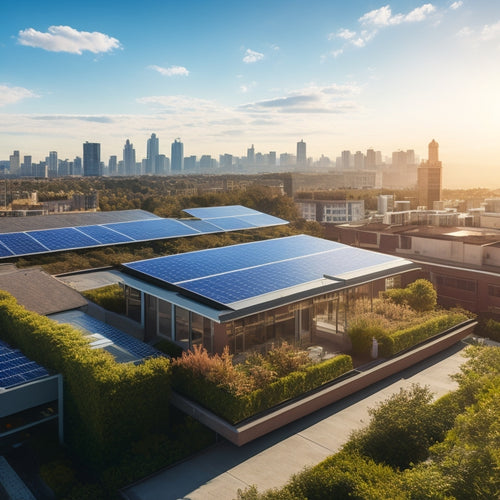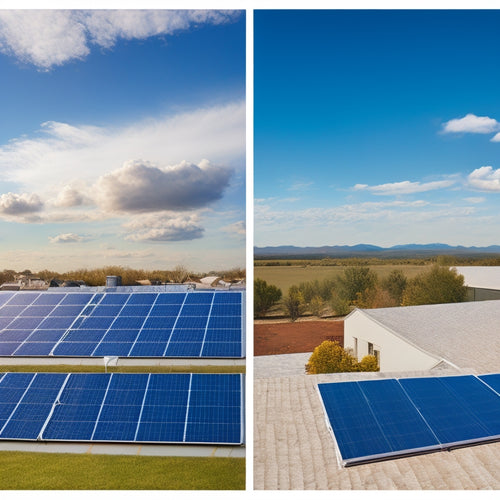
Solar Panels as a Viable Electricity Source
Share
As you investigate solar panels as a viable electricity source, you'll find that recent innovations have improved their efficiency and cost-effectiveness. With abundant sunlight available everywhere, solar energy reduces your reliance on fossil fuels, leading to a decrease in carbon emissions and air pollutants. You can install solar panels on your rooftop or in solar farms, and with proper assessment, determine the number of panels you need. As you consider solar power, you'll reveal its numerous benefits, from improved air quality and economic incentives to increased energy independence. Now, you're just beginning to unveil the advantages of utilizing the sun's energy, and there's more to investigate.
Key Takeaways
- Solar panels convert sunlight into electricity, offering an abundant and ubiquitous energy source with various installation options.
- Solar energy reduces reliance on fossil fuels, decreasing carbon emissions and improving air quality and public health.
- Recent innovations have improved the efficiency and cost-effectiveness of solar materials, making solar energy a competitive option.
- Government incentives, financing options, and community programs promote solar adoption, enhancing energy equity and accessibility.
- Solar panels have become increasingly affordable, with decreasing costs making solar energy a viable alternative to fossil fuels.
Harnessing Power From the Sun
The sun's energy is abundant and available everywhere, making it an ideal source of power. You can tap into this energy through solar panels, which convert sunlight into electricity. Recent solar energy innovations have led to more efficient and cost-effective solar panel materials. These advancements have made solar panels a viable option for generating electricity.
You can exploit power from the sun by installing solar panels on your rooftop or in a solar farm. The panels consist of photovoltaic cells made from semiconductor materials like silicon. When sunlight hits these cells, it excites the electrons, generating an electric current. The panels are designed to maximize energy absorption, and the latest solar panel materials have improved their efficiency.
As you consider exploiting power from the sun, you'll want to assess your energy needs and determine the number of solar panels required to meet your requirements. With the right setup, you can enjoy a reliable and sustainable source of electricity, reducing your reliance on traditional power sources.
Environmental Benefits of Solar Energy
As you consider solar panels as an electricity source, you'll find that they offer several environmental benefits.
By capturing power from the sun, you're reducing your reliance on fossil fuels and subsequently decreasing carbon emissions.
This clean energy source also produces no air pollutants, making it a significant contributor to cleaner air and a healthier planet.
Reduced Carbon Emissions
Carbon footprint reduction is a crucial aspect of shifting to solar energy, and you're likely to reap significant environmental benefits by doing so. By utilizing solar power, you'll reduce your reliance on fossil fuels, which are a primary contributor to climate change. This, in turn, will help minimize your carbon footprint and slow the pace of global warming.
| Emissions Reduction | Equivalent Environmental Benefit |
|---|---|
| 1 ton of CO2 | Planting 25 trees and letting them grow for 10 years |
| 10 tons of CO2 | Conserving 120,000 gallons of gasoline |
| 50 tons of CO2 | Reducing carbon emissions from 10,000 miles of driving |
| 100 tons of CO2 | Preventing 100,000 pounds of coal from being burned |
| 500 tons of CO2 | Saving 1,000 acres of forest from deforestation |
Clean Air Production
Solar energy's clean air production is a significant environmental benefit, directly impacting air quality. By utilizing solar power, you reduce your reliance on fossil fuels, which are notorious air pollutants. This, in turn, leads to improved air quality, resulting in substantial health benefits for you and your community.
Sustainable practices, such as adopting solar energy, are essential in urban planning, as they mitigate the adverse effects of air pollution on public health. Community initiatives, like rooftop solar installations, can also contribute to cleaner air.
Government policies, incentivizing the adoption of solar energy, can additionally accelerate this trend. The economic impact of clean air production is substantial, as it reduces healthcare costs and increases productivity.
Moreover, innovation trends in solar technology are continually improving efficiency and reducing costs, making clean air production more accessible and affordable. By embracing solar energy, you're not only generating electricity but also contributing to a healthier, more sustainable environment.
Renewable Energy Source
Your decision to employ solar energy changes your home into a renewable energy hub, yielding a significant impact on the environment. By leveraging the power of the sun, you're contributing to a cleaner, more sustainable future. As a renewable energy source, solar energy reduces reliance on fossil fuels, decreasing greenhouse gas emissions and mitigating climate change.
| Benefits | Description | Impact |
|---|---|---|
| Energy Independence | Reduces reliance on grid electricity | Increased energy equity |
| Job Creation | Drives growth in the solar industry | Enhances local economies |
| Technological Advancements | Improves panel efficiency and storage capacity | Augments energy independence |
| Public Awareness | Increases adoption and demand for solar energy | Accelerates market trends |
Solar energy also benefits from policy structures and solar incentives, which encourage adoption and drive innovation. Community projects and financing options make solar energy more accessible, promoting energy equity and job creation. As you join the solar revolution, you're part of a larger movement towards a sustainable, renewable energy future.
Cost-Effective Electricity Generation
As the global demand for electricity continues to rise, finding an efficient way to generate power has become a top priority. You're likely considering solar panels as a viable option, but you're wondering if they're cost-effective. The good news is that solar panels have become increasingly affordable, making them a competitive choice for electricity generation.
Several factors contribute to the cost-effectiveness of solar panels:
-
Government incentives: Many governments offer tax credits, grants, or rebates to encourage the adoption of solar energy.
-
Financing options: You can investigate financing options like solar leasing or power purchase agreements to reduce upfront costs.
-
Community solar: Join a community solar program to share the costs and benefits of a solar array with your neighbors.
-
Residential installations: Installing solar panels on your rooftop can provide a significant return on investment through reduced energy bills.
-
Utility partnerships: Collaborate with your utility company to take advantage of net metering and other incentives.
Solar Panel Efficiency and Technology
You're likely wondering how efficiently solar panels convert sunlight into electricity.
The energy conversion rate of a solar panel is a critical factor in its overall performance, and it's influenced by the type of photovoltaic cells used.
As you investigate advanced cell designs, you'll uncover how they impact the panel's ability to utilize energy from the sun.
Energy Conversion Rates
The conversion of sunlight into electrical energy is a complex process, reliant on the efficiency of solar panels to capture and convert photons into usable power. As you consider solar panels as a viable electricity source, it's crucial to understand the energy conversion rates that determine their effectiveness.
When evaluating solar panels, you'll come across various energy efficiency ratings, which indicate the percentage of sunlight converted into electricity. Currently, commercial solar panels have an average energy efficiency of around 20%. However, advances in conversion technologies have led to the development of more efficient panels, with some reaching efficiencies of over 26%.
Some key factors influencing energy conversion rates include:
-
Thermal management: Effective heat management systems help maintain ideal operating temperatures, ensuring higher energy conversion rates.
-
Cell design: Innovative cell designs and structures can improve photon absorption and conversion.
-
Material quality: High-purity materials with minimal defects enable more efficient energy conversion.
-
Surface textures: Enhanced surface textures can increase photon absorption and reduce reflection losses.
-
Anti-reflective coatings: These coatings minimize reflection and maximize photon absorption, leading to higher energy conversion rates.
Advanced Cell Designs
Silicon wafers, the backbone of solar cells, have undergone significant changes to enhance energy conversion rates. You're likely familiar with traditional solar panels, but advanced cell designs have taken efficiency to the next level.
Bifacial panels, for instance, can absorb light from both the front and back sides, increasing energy output by up to 25%. Perovskite cells have also shown promising results, with power conversion efficiency rates reaching as high as 23.6%.
Transparent solar cells have opened up new possibilities for building-integrated photovoltaics, where windows and building facades can generate electricity. Thin film technology has reduced production costs and increased flexibility, while multi-junction cells have pushed efficiency boundaries even further.
Organic photovoltaics and quantum dot technology are also being investigated for their potential to increase energy conversion rates.
Solar tracking systems optimize panel angles to maximize energy output, and integrated photovoltaics are being incorporated into building designs to create sustainable, energy-harvesting structures.
These advanced cell designs are revolutionizing the solar industry, making it an increasingly viable option for powering your home or business. As technology continues to evolve, you can expect even more innovative solutions to emerge.
Installation and Maintenance Considerations
Several factors come into play when considering the installation and maintenance of solar panels as a reliable electricity source.
You'll need to assess your site's energy potential, guaranteeing ideal panel placement and orientation. Securing installation permits from local authorities is also vital, as is selecting a qualified installer with a proven track record.
When it comes to maintenance, you'll want to establish schedules for routine cleaning and inspections to confirm peak performance.
Don't forget to implement safety protocols for emergency situations. To monitor your system's performance, you'll need to invest in a monitoring system that provides real-time data analysis. This will enable you to identify areas for improvement and enhance energy output.
- Conduct a thorough site assessment to determine energy potential
- Obtain necessary installation permits from local authorities
- Research and select a qualified installer with a proven track record
- Establish maintenance schedules for routine cleaning and inspections
- Implement safety protocols for emergency situations
Grid Connection and Energy Storage
Once you've confirmed your solar panel system is installed and maintained properly, it's time to investigate how to connect it to the grid and store excess energy.
Grid integration is a vital step in utilizing the full potential of your solar panels. You'll need to guarantee your system meets the technical requirements for grid connection, including synchronization with the grid's frequency and voltage. This will allow you to feed excess energy back into the grid and offset your electricity bills.
To optimize your energy storage, consider investing in battery systems. These systems enable you to store excess energy generated during the day for use during the night or on cloudy days.
Battery systems can also provide backup power during grid outages, confirming you have a reliable source of electricity. When selecting a battery system, consider factors such as capacity, depth of discharge, and round-trip efficiency to guarantee you get the most out of your investment.
Future of Solar Electricity Generation
As the world shifts towards a more sustainable energy mix, you're likely wondering what the future holds for solar electricity generation. The good news is that the outlook is promising, with solar power expected to play an increasingly prominent role in the global energy framework.
Several factors will drive this growth, including:
-
Improved technology: Advancements in panel efficiency, energy storage, and smart grid infrastructure will enhance the reliability and affordability of solar power.
-
Solar policy: Governments worldwide are implementing supportive policies, such as tax credits and feed-in tariffs, to encourage the adoption of solar energy.
-
Energy incentives: Financial incentives, like net metering and renewable portfolio standards, will continue to drive investment in solar infrastructure.
-
Decreasing costs: The cost of solar panels and installation has fallen dramatically in recent years, making solar energy more competitive with fossil fuels.
-
Grid parity: As solar energy reaches grid parity in more regions, it will become an increasingly viable alternative to traditional energy sources.
As these factors converge, you can expect solar electricity generation to become an increasingly important component of the global energy mix.
Frequently Asked Questions
Can Solar Panels Be Used in Cloudy or Shady Areas?
You'll find that solar panels can still generate power in cloudy or shady areas, but shading impacts will reduce solar efficiency. Even with indirect sunlight, you'll still produce some electricity, although at a lower capacity than in ideal conditions.
How Long Do Solar Panels Last Before Replacement?
As you commence on utilizing the power of the sun, you'll want to know that your solar panels are built to last, with a lifespan of 25-30 years, requiring minimal maintenance to guarantee peak energy harvest, giving you a decade-long reign of clean energy supremacy.
Can I Install Solar Panels Myself or Diy?
You can install solar panels yourself, but you'll need to contemplate DIY considerations like ensuring a watertight seal and proper electrical connections; follow installation tips like evaluating your roof's structural integrity and optimizing panel placement for maximum energy output.
Do Solar Panels Increase My Property Value?
You'll be interested to know that 80% of homebuyers consider energy efficiency important. Installing solar panels can increase your property value, providing financial incentives like tax credits and rebates, which may also lower your home insurance premiums.
Are Solar Panels Noisy or Produce Any Sound?
You'll be relieved to know that solar panels operate silently, producing no audible sound. In fact, they're quieter than a whisper, with a sound level of around 20 decibels, comparable to a quiet library. Regular solar panel maintenance guarantees this remains the case.
Related Posts
-

Master Advanced Solar Panel Design Online for Free
You can master advanced solar panel design online for free by leveraging specialized courses and training platforms, ...
-

What Is the Cost to Put in Solar Panels
You're likely considering solar panels for your home, and the most significant factor in your decision is the upfront...
-

Tracking Solar Panels Vs Fixed Panels Cost Savings
When considering solar panel options, you'll want to weigh the cost savings of tracking solar panels versus fixed pan...


